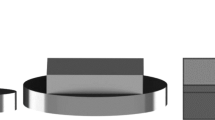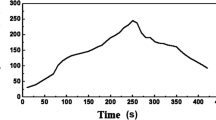Abstract
Ceramic-metal composite components manufactured by brazing/soldering technology have broad application in industry due to their excellent properties. The present study investigated soldering of Al2O3 ceramic with Al2O3 ceramic, copper, and 5056 aluminum alloy respectively by using a new type Sn-Zn-Sb solder at 250 °C in air with the assistance of ultrasonic. Microstructure of the Sn-9Zn-xSb solders with various content of Sb was analyzed. And the effect of Sb content on ceramic/ceramic joint strength was studied. The microstructures of solder/substrate interfaces and the bonding mechanism were emphatically studied. A significantly new intermetallic phase, Zn4Sb3 is detected in the microstructure of solder while the content of Zn4Sb3 and β-Sn phases increased with the content of Sb element. During the soldering process, Sn-Zn-Sb solder was composed of liquid Sn-Zn alloy and solid ZnSb intermetallic phase, and the quasi-melting state of the solder was found to be the decisive factor in achieving reliable ceramic/solder bonds. There was no reaction layer at ceramic/solder interface, and the solder filled grooves on the ceramic surface to form a firm mechanical bonding, thus results in higher strength. Fractures occurred on the ceramic/solder interface and Zn4Sb3 particles were found embedded in ceramic side.












Similar content being viewed by others
References
Wang Y, Zhao YT, Yang ZW et al (2018) Microstructure, residual stress and mechanical properties of Al2O3/Nb joints vacuum-brazed with two Ag-based active fillers. Vacuum 158:14–23
Sun RJ, Zhu Y, Guo W et al (2018) Microstructural evolution and thermal stress relaxation of Al2O3/1Cr18Ni9Ti brazed joints with nickel foam. Vacuum 148:18–26
Qiu QW, Wang Y, Yang ZW et al (2016) Microstructure and mechanical properties of Al2O3 ceramic and Ti6Al4V alloy joint brazed with inactive Ag-Cu and Ag-Cu + B. J Eur Ceram Soc 36:2067–2074
Niu GB, Wang DP, Yang ZW et al (2016) Microstructure and mechanical properties of Al2O3 ceramic and TiAl alloy joints brazed with Ag–Cu–Ti filler metal. Ceram Int 42:6924–6934
do Nascimento RM, Martinelli AE, AJA B (2003) Review article: recent advances in metal-ceramic brazing. Cerâmica 49:178–198
Pan LM, Gu J et al (2018) Brazing joining of Ti3AlC2 ceramic and 40Cr steel based on Ag-Cu-Ti filler metal. J Mater Process Tech 251:181–187
Yang J, Huang JH, Ye Z et al (2018) Influence of interfacial reaction on reactive wettability of molten Ag-Cu-X wt.%Ti filler metal on SiC ceramic substrate and mechanism analysis. Appl Surf Sci 436:768–778
Zhang DK, Wang KH, Yang ZM et al (2008) Process of electroless copper plating on Al2O3 ceramics and its soldering at low temperature. Transac China Weld Inst 29(4):33–36
Kolenak R, Kostolný I, Sahul M (2016) Direct bonding of silicon with solders type Sn-Ag-Ti. Sold Surf Mount Technol 28(3):149–158
Cheng LX, Liu MR, Wang XQ (2017) Effects of active element Ti on interfacial microstructure and bonding strength of SiO2/SiO2, joints soldered using Sn3.5Ag4Ti(Ce,Ga) alloy filler. Mater Sci Eng A 680:317–323
Wu B, Guo W, He J (2018) Microstructure evolution of SiC/SiC joints during ultrasonic-assisted air bonding using a Sn–Zn–Al alloy. Ceram Int 44(2):1284–1290
Yonekura D, Ueki T, Tokiyasu K (2015) Bonding mechanism of lead-free solder and glass plate by ultrasonic assisted soldering method. Mater Des 65:907–913
Matsuka SI (1998) Ultrasonic welding of ceramic/metals using inserts. J Mater Process Technol 75:259–265
Iijima M, Watanabe Y (2001) Ultrasonic joining of silicon nitride plates without an adhesive material using 19 kHz vibration system. Jpn J Appl Phys 40:3789–3791
Imai H, Matsuoka SI (2006) Direct welding of metals and ceramics by ultrasonic vibration. JSME Int J Ser A 49:444–450
Rass IJ (2016) Ultrasonic soldering of metals, light metals, glasses and ceramics. Brazing, High Temperature Brazing and Diffusion Bonding (LÖT 2016). Aachen, Germany, 2016.06, 12-16
Shen P, Fujii H, Matsumoto T, Nogi K (2003) Wetting of (0001) -Al2O3 single crystals by molten Al. Scr Mater 48:79–84
Shen P, Fujii H, Matsumoto T, Nogi K (2003) The influence of surface structure on wetting of α-alumina by Al in a reduced atmosphere. Acta Mater 51:897–906
Ownby PD, Wen K, Li K et al (1991) High-temperature wetting of sapphire by aluminum. J Am Ceram Soc 74:75–81
Qu W, Zhou S, Zhuang H (2015) Effect of Ti content and Y additions on oxidation behavior of SnAgTi solder and its application on dissimilar metals soldering. Mater Des 88:737–742
Cheng LX, Li GY, Wang XQ (2016) Influence of active element Ti on interfacial reaction and soldering strength between Sn3.5Ag4Ti(Ce,Ga) alloy filler and Si substrate. Mater Sci Eng A 658:42–49
Qu WQ, Qi ZG, Zhuang HS (2007) Green active packaging process of ceramic to metal for electron device. Chin J Electron Dev 30(2):376–379
Gorjan L, Blugan G, Boretius M (2015) Fracture behavior of soldered Al2O3, ceramic to A356 aluminum alloy and resistance of the joint to low temperature exposure. Mater Des 88:889–896
Nagaoka T, Morisada Y, Fukusumi M (2010) Ultrasonic-assisted soldering of 5056 aluminum alloy using quasi-melting Zn-Sn alloy. Metall Mater Transac B 41(4):864–871
Funding
The authors wish to thank the financial support from the Ministry of Science and Technology of the People’s Republic of China, under the key special projects of the national key R&D program 2017YFB0305700.
Author information
Authors and Affiliations
Corresponding author
Additional information
Publisher’s note
Springer Nature remains neutral with regard to jurisdictional claims in published maps and institutional affiliations.
Recommended for publication by Commission XVII - Brazing, Soldering and Diffusion Bonding
Rights and permissions
About this article
Cite this article
Wu, Y., Li, H., Qu, W. et al. Ultrasonic-assisted bonding of Al2O3 ceramic, Cu, and 5056 aluminum alloy with Sn-Zn-Sb solders. Weld World 64, 247–256 (2020). https://doi.org/10.1007/s40194-019-00815-z
Received:
Accepted:
Published:
Issue Date:
DOI: https://doi.org/10.1007/s40194-019-00815-z




